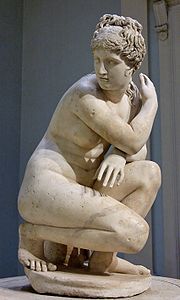
Lely Venus
Encyclopedia

Crouching Venus
The Crouching Venus is a Hellenistic model of Venus surprised at her bath. Venus crouches with her right knee close to the ground, turns her head to the right and, in most versions, reaches her right arm over to her left shoulder to cover her breasts...
type of Hellenistic marble statue. It is of Antonine date.

House of Gonzaga
The Gonzaga family ruled Mantua in Northern Italy from 1328 to 1708.-History:In 1433, Gianfrancesco I assumed the title of Marquis of Mantua, and in 1530 Federico II received the title of Duke of Mantua. In 1531, the family acquired the Duchy of Monferrato through marriage...
collection in Mantua
Mantua
Mantua is a city and comune in Lombardy, Italy and capital of the province of the same name. Mantua's historic power and influence under the Gonzaga family, made it one of the main artistic, cultural and notably musical hubs of Northern Italy and the country as a whole...
, where it was inventoried in the Gonzaga collection in 1627 Whilst there it was seen by the artist Rubens, who stayed with the Gonzaga family whilst on the continent on diplomatic and art-collecting duties for Charles I of England
Charles I of England
Charles I was King of England, King of Scotland, and King of Ireland from 27 March 1625 until his execution in 1649. Charles engaged in a struggle for power with the Parliament of England, attempting to obtain royal revenue whilst Parliament sought to curb his Royal prerogative which Charles...
. It was an important influence on his voluptuous style of painting the female nude, so much so that it appeared at the National Gallery
National Gallery, London
The National Gallery is an art museum on Trafalgar Square, London, United Kingdom. Founded in 1824, it houses a collection of over 2,300 paintings dating from the mid-13th century to 1900. The gallery is an exempt charity, and a non-departmental public body of the Department for Culture, Media...
's "Rubens: A Master in the Making" exhibition from 26 October 2005 to 15 January 2006
It was soon purchased from the Gonzagas, in 1627-28, for Charles I of England
Charles I of England
Charles I was King of England, King of Scotland, and King of Ireland from 27 March 1625 until his execution in 1649. Charles engaged in a struggle for power with the Parliament of England, attempting to obtain royal revenue whilst Parliament sought to curb his Royal prerogative which Charles...
, It was remarked in England in 1631 as "the finest statue of all" and valued at 6000 ecus
Écu (coin)
The term écu may refer to one of several French coins. The first écu was a gold coin minted during the reign of Louis IX of France, in 1266. Ecu means shield, and the coin was so called because its design included a shield bearing a coat of arms. The word is related to scudo and escudo...
.. On the dispersal of Charles's art collections during the Commonwealth
Commonwealth of England
The Commonwealth of England was the republic which ruled first England, and then Ireland and Scotland from 1649 to 1660. Between 1653–1659 it was known as the Commonwealth of England, Scotland and Ireland...
, it came into the possession of the painter and connoisseur Sir Peter Lely
Peter Lely
Sir Peter Lely was a painter of Dutch origin, whose career was nearly all spent in England, where he became the dominant portrait painter to the court.-Life:...
, from whom it derives its name. Two years after Lely's death it was re-acquired from his collection for the Royal Collection
Royal Collection
The Royal Collection is the art collection of the British Royal Family. It is property of the monarch as sovereign, but is held in trust for her successors and the nation. It contains over 7,000 paintings, 40,000 watercolours and drawings, and about 150,000 old master prints, as well as historical...
. It was housed in the Palace of Whitehall
Palace of Whitehall
The Palace of Whitehall was the main residence of the English monarchs in London from 1530 until 1698 when all except Inigo Jones's 1622 Banqueting House was destroyed by fire...
at the time of the fire which destroyed that palace on January 4, 1698, and was rescued from the flames. Since 2005 it has been on long-term loan to British Museum, following treatment by their conservators, and is currently on display in gallery 23.

